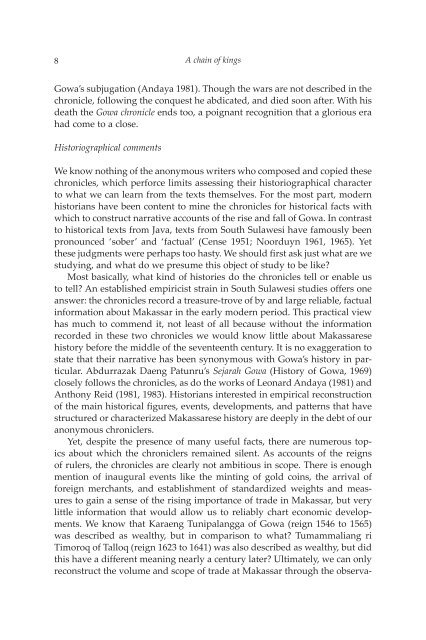A CHAIN OF KINGS - Books and Journals
A CHAIN OF KINGS - Books and Journals
A CHAIN OF KINGS - Books and Journals
You also want an ePaper? Increase the reach of your titles
YUMPU automatically turns print PDFs into web optimized ePapers that Google loves.
8<br />
A chain of kings<br />
Gowa’s subjugation (Andaya 1981). Though the wars are not described in the<br />
chronicle, following the conquest he abdicated, <strong>and</strong> died soon after. With his<br />
death the Gowa chronicle ends too, a poignant recognition that a glorious era<br />
had come to a close.<br />
Historiographical comments<br />
We know nothing of the anonymous writers who composed <strong>and</strong> copied these<br />
chronicles, which perforce limits assessing their historiographical character<br />
to what we can learn from the texts themselves. For the most part, modern<br />
historians have been content to mine the chronicles for historical facts with<br />
which to construct narrative accounts of the rise <strong>and</strong> fall of Gowa. In contrast<br />
to historical texts from Java, texts from South Sulawesi have famously been<br />
pronounced ‘sober’ <strong>and</strong> ‘factual’ (Cense 1951; Noorduyn 1961, 1965). Yet<br />
these judgments were perhaps too hasty. We should first ask just what are we<br />
studying, <strong>and</strong> what do we presume this object of study to be like?<br />
Most basically, what kind of histories do the chronicles tell or enable us<br />
to tell? An established empiricist strain in South Sulawesi studies offers one<br />
answer: the chronicles record a treasure-trove of by <strong>and</strong> large reliable, factual<br />
information about Makassar in the early modern period. This practical view<br />
has much to commend it, not least of all because without the information<br />
recorded in these two chronicles we would know little about Makassarese<br />
history before the middle of the seventeenth century. It is no exaggeration to<br />
state that their narrative has been synonymous with Gowa’s history in particular.<br />
Abdurrazak Daeng Patunru’s Sejarah Gowa (History of Gowa, 1969)<br />
closely follows the chronicles, as do the works of Leonard Andaya (1981) <strong>and</strong><br />
Anthony Reid (1981, 1983). Historians interested in empirical reconstruction<br />
of the main historical figures, events, developments, <strong>and</strong> patterns that have<br />
structured or characterized Makassarese history are deeply in the debt of our<br />
anonymous chroniclers.<br />
Yet, despite the presence of many useful facts, there are numerous topics<br />
about which the chroniclers remained silent. As accounts of the reigns<br />
of rulers, the chronicles are clearly not ambitious in scope. There is enough<br />
mention of inaugural events like the minting of gold coins, the arrival of<br />
foreign merchants, <strong>and</strong> establishment of st<strong>and</strong>ardized weights <strong>and</strong> measures<br />
to gain a sense of the rising importance of trade in Makassar, but very<br />
little information that would allow us to reliably chart economic developments.<br />
We know that Karaeng Tunipalangga of Gowa (reign 1546 to 1565)<br />
was described as wealthy, but in comparison to what? Tumammaliang ri<br />
Timoroq of Talloq (reign 1623 to 1641) was also described as wealthy, but did<br />
this have a different meaning nearly a century later? Ultimately, we can only<br />
reconstruct the volume <strong>and</strong> scope of trade at Makassar through the observa-









![Am HaSefer [Volk des Buches] - Books and Journals](https://img.yumpu.com/20648352/1/174x260/am-hasefer-volk-des-buches-books-and-journals.jpg?quality=85)







